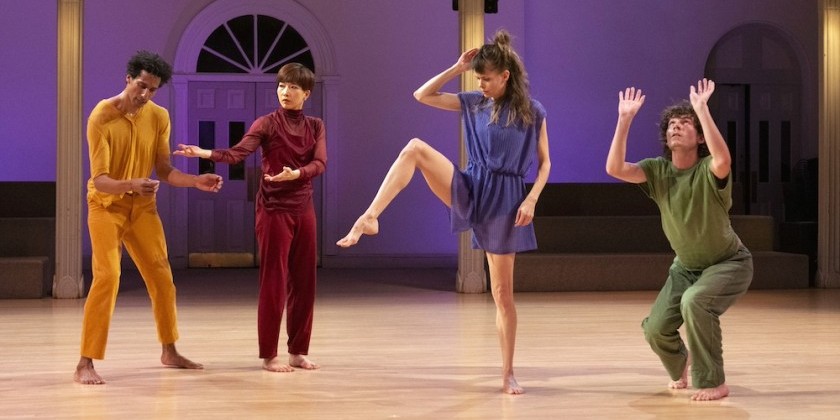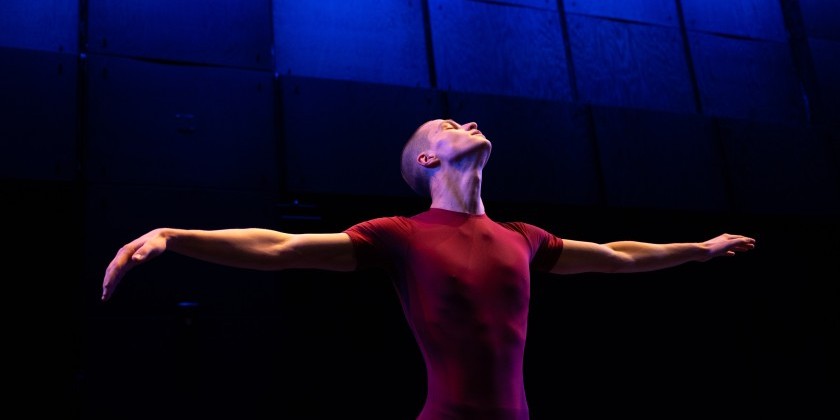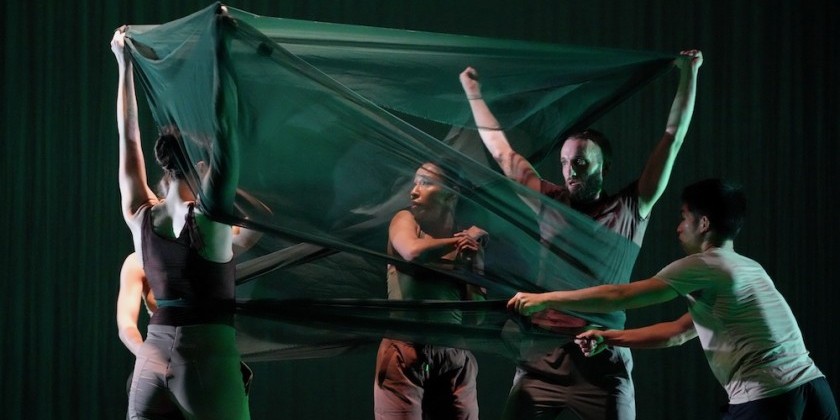IMPRESSIONS: Stacy Matthew Spence's “I am, here; Here with us; Where we find ourselves” at Danspace Project

Choreographer: Stacy Matthew Spence
Co-creators and performers: Tim Bendernagel, Joanna Kotze, Hsiao-jou Tang and Stacy Matthew Spence
Composers and musicians: Charlotte Jacobs and Raf Vertessen
Costumer: Athena Kokoronis
Archival Surface: Myssi Robinson
Lighting designer: Carol Mullins
Technical director: Niko Tsocanos
Production support team: Rosaly Ruiz, Seta Morton, Lily Cohen
Dancers in cover image: Stacy Matthew Spence, Hsiao-jou Tang, Joanna Kotze, and Tim Bendernage.
There is a distinct sense of comfort within the sanctuary of St. Mark’s Church in-the-Bowery, home to Danspace Project. Each time I visit I settle in with palpable pleasure and relief. The high ceilinged, warmly lit space holds me without restraint; it is humble in its grandeur and clearly tended to with care and intention. As a place of worship, the church is a space that lends itself naturally to contemplation and connection, which Danspace reflects amply in their expansive programming that probes the many dimensions of dancemaking. And more often than not, these values resonate in the content of the particular dance works presented in the space. I am grateful for the way the church’s sanctuary and Danspace hold me as an artist: a curious mind, a restless body, and a human being (like all of us) who is from time to time in need of solace.
Choreographer and dancer Stacy Matthew Spence’s brief and luminous trilogy of dances “I am, here; Here with us; Where we find ourselves” provides such solace and continues to hold me days later. The perfectly spare production is a visual pleasure, a sound bath, and a spa for the soul. In it, Spence and his collaborators address three interconnected questions around self, space, and community: “How do we find ourselves? How do we find our place? How do we find each other?” These are big, broad questions that Spence manages to approach without falling into traps of easy literality or overwrought sentimentality, favoring instead a deeply intuitive attunement to sensation.
Spence’s approachable blend of softly pedestrian formalism tracks with his longtime affiliation with the Trisha Brown Dance Company while transcending its more opaque postmodernist tones. His movement language speaks for itself — volubly inventive yet uncrowded — and within it he and his three excellent castmates speak for themselves. Clad in elegantly textured, richly hued monochromes by Athena Kokoronis, their auras exude even more subtly luxurious textures and hues. Composer-performers Charlotte Jacobs and Raf Vertessen co-pilot their collective journey through an alternately melodious, meditative, and percussive score, guiding and conversing with the dancing bodies before them. Throughout, silence and stillness are ample, welcome, and respected.
The 40-minute program opens with “I am, here,” a solo for Spence in glowing goldenrod. His movement takes the heart as its center, tracing arcs and circles and pensive reaches along a distant high diagonal with gestures floated, forgotten, and remembered. Through intervals of percussion and silence (this is really a duet with Vertessen at the drum kit), he is lithe and organized through energetic bursts — jangles, stomps, full bodied vibrations — and present stillnesses. His clarity and honesty allow his gestures to see, his vision to speak, and the whole room to listen with our whole selves. His widespread arms make a poetically-unified twofold statement of self-recognition and embodied presence: “I am” / “here.”
Stacy Matthew Spence and Raf Vertessen (background). Photo: Elyssa Goodman
Joanna Kotze, in rippling periwinkle blue, pads into the space to join Spence in the duet “Here with us.” They start off as strangers who steal glances and retreat into private preoccupations, their gestures palpating and uncertain through disconnected orbits and trajectories. Jacobs’s voice rises from soft hums to wordless tones and echoes that thicken the air, ripening it for Vertessen’s percussive interventions, together casting a spell to conjure an alchemical “us.” The two dancers play with seeing and feeling across distance, closeness, and brief contact, wrestling with the intangible as limbs dart out with fleeting certainty, eyes and hands full and searching. As they draw closer, their touch grows from tentative to supportive to essential; in their elastic entanglements they find risk, trust, and companionship. They close by joining their “us” to our “us,” seated together on the floor between audience members.

The quartet “Where we find ourselves” welcomes Tim Bendernagel (in hay green) Hsiao-jou Tang (in garnet red) into an iterative community building that holds each individual as precious, indispensable, and inevitably drawn to connection. Ambling through scattered postures and gestures, tableaus coalesce and dissolve as each dancer’s attitude flickers into focus. Tang is refined and exacting while Bendernagel bounds and trembles in his search. Spence and Kotze stand and sit pensively, a unit apart, though they remain integral as shapes and gestures recur and pass through their bodies in unpredictable flashes of recognition.
As each dancer simultaneously finds their “I am” / “here,” they build from their autonomies a collectivity of shared space, language, and understanding. Sounds rise to meet their mounting flurry of knowing spontaneity, full of near misses, breathless falls, and delicate counterbalances. Their impeccable timing in sculptured juxtapositions reveals simple movements in their fullest beauty: a decisive stomp, a sweeping slice, a brief flight, a twisting skip, a gentle touch. Bodies open with heaving breath, they cluster together, each with one hand to another’s shoulder in a now unbreakable chain of connection. Fading into darkness, the voice lingers to absorb their presence into ours.
As I headed home I found myself cracked open, unconsciously feeling the place around me and my place in it. From the cold walk through the long train ride, I felt the others around me come into full relief: the content of gestures and faces, of posture, carriage, and stride. Any New Yorker knows that though the city overflows with people, it’s still easy to feel lonely; this is something I both struggle with and love about the city. Spence’s dances offer a way through: finding self and building community with attention, sensation, and empathy that begin within, rippling outward with quiet power.















